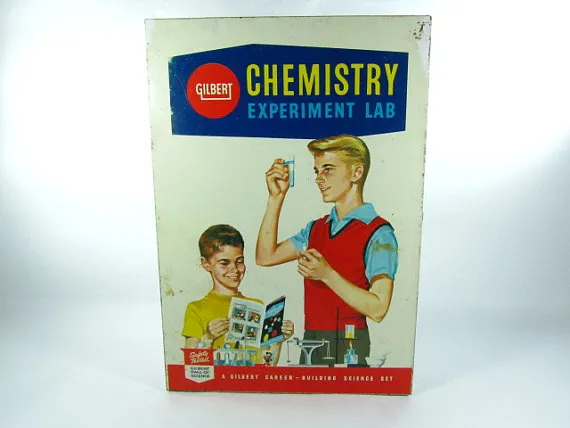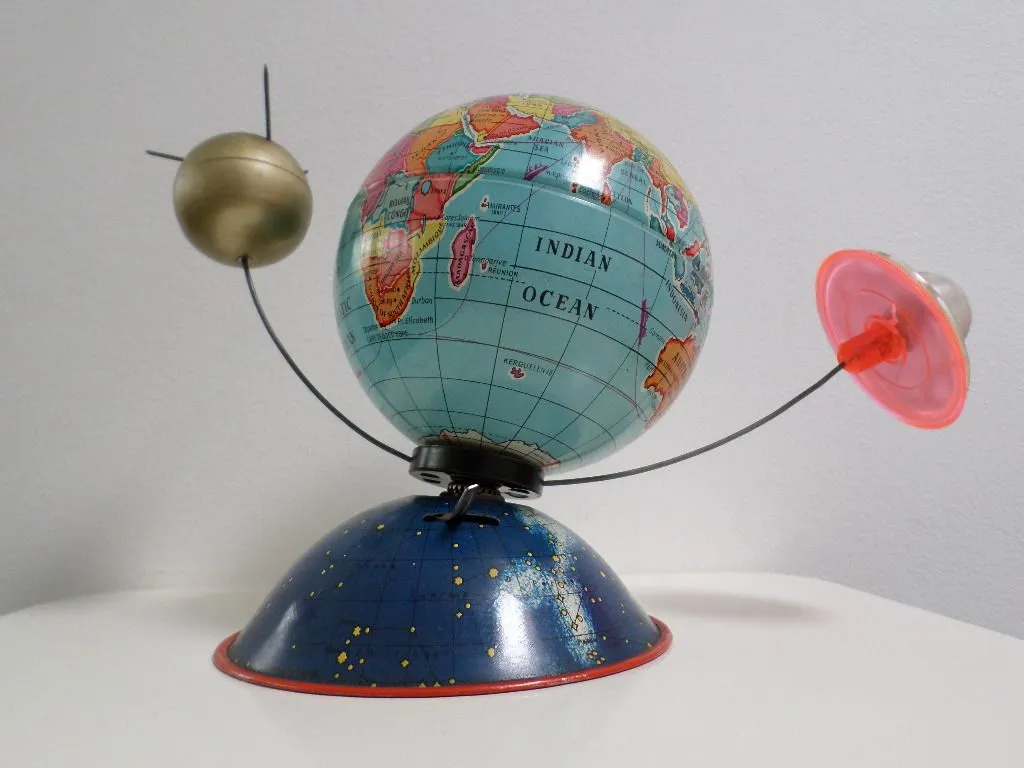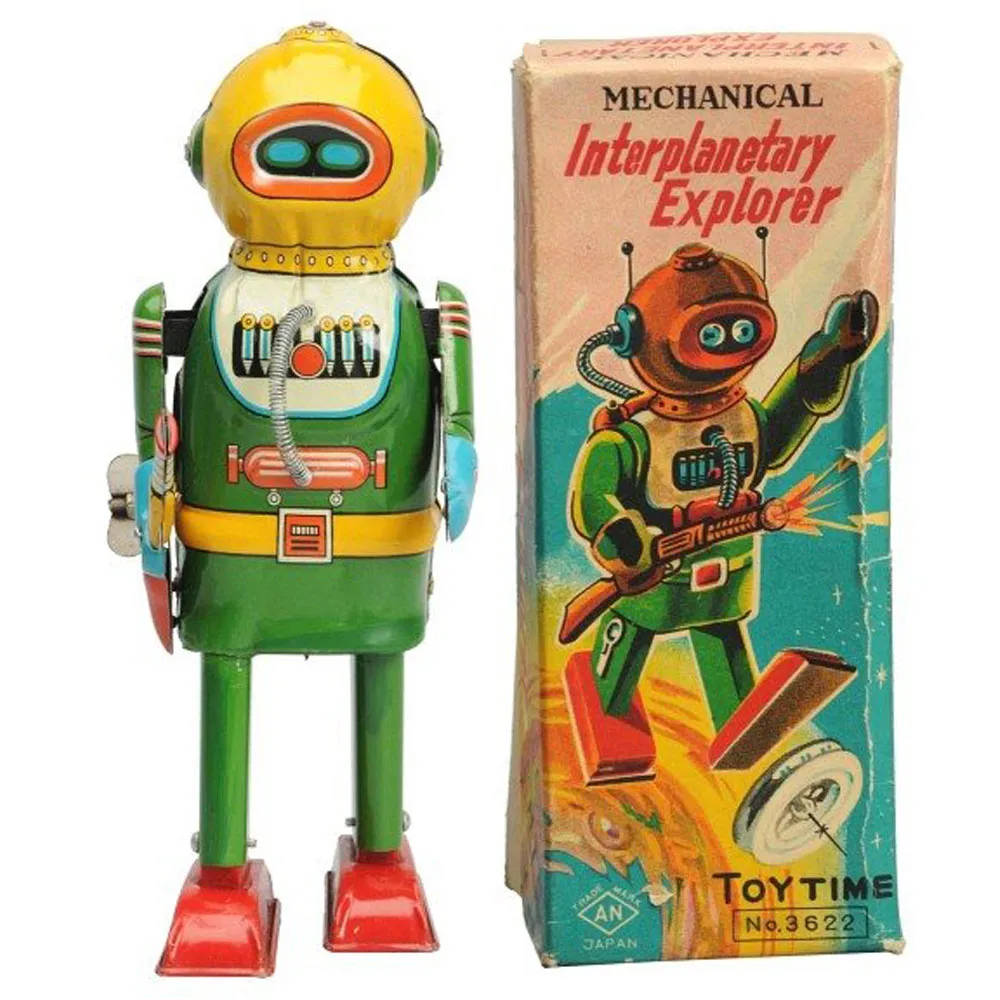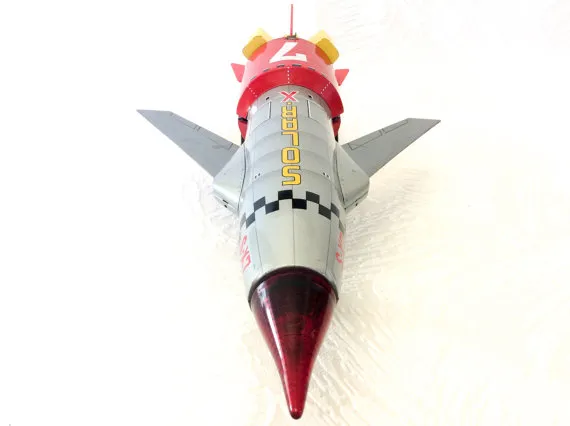‘The past is a foreign country: they do things differently there.’ LP Hartley’s famous quote from The Go-Between is particularly apt for the splendidly wacky, wonderful and often bizarre world of 1950s space toys.
Splitting the atom was a hot topic back in the Fifties. During the so-called Atomic Age, scientific advances influenced industrial and commercial design and together with the Space Race – a by-product of the Cold War – became a stylistic driving force in an otherwise conservative decade.
It’s almost impossible to contemplate today but as late as 1963 the US Atomic Energy Commission encouraged holiday tourism at their Nevada nuclear test site (a disturbing 65 miles from Las Vegas) where sunglasses-wearing families flocked in their thousands to witness the detonation of atmospheric nuclear bombs.
Atomic particles became a mainstay of visual design. Geometric atomic patterns were reproduced on textiles, countertops, wallpaper, amoebic coffee tables, futuristic pieces of furniture and toys. Take the colourful wooden pull toy pictured above, for example. Its seemingly simple structure is based on the pattern of atomic molecules.
Other bizarre nuclear-themed toys of mass destruction included the Uranium Rush game (slogan: ‘Make a million dollars! Your Geiger Counter lights and buzzes your way to fun and fortune’), the Cap Shooting Giant Atomic Bomb (‘Safe and harmless’), a tinplate ICBM Control Range Rocket Launching Station and an Atom Bomber toy, which featured an ‘automatic metal bomb release’, plus a ‘colourful target box’.

Budding nuclear physicists meanwhile might have hoped to wake up one sunny 1950s Christmas morning to a Gilbert U-238 Atomic Energy Laboratory Set complete with Wilson cloud chamber, Geiger-Mueller counter, (‘developed at the Gilbert Hall of Science with the country’s leading atomic energy scientists,’ it claimed), spinthariscope (an instrument for watching nuclear radiation), four uranium-bearing ore samples and a comic book explaining how to split the atom.
The set also came with a $10,000 reward, payable by the United States Government to any child discovering ‘substantial deposits of uranium ore’. Full details were given in the accompanying booklet, Prospecting for Uranium. With a relatively high price tag of $49.50, the set didn’t sell especially well and after a few years was withdrawn from sale.

Less disturbing to modern sensibilities is this charming tinplate clockwork toy, manufactured by the West German toy company, Michael Seidel. It features a metallic Sputnik 1 (the first man-made satellite in space) and a very 1950s-looking pink plastic flying saucer revolving around a terrestrial globe.
Space, thanks to the Space Race, was the big thing. During the Cold War a plethora of toy flying saucers, rocket launchers, space tanks, ray guns, space ships and robots was produced. For connoisseurs of the tinplate toy, the 1950s was a golden age: occupied Japan and Western Germany were prominent exporters of beautifully made toys, partly in an attempt to revive their damaged post-War economies. The appeal of vintage tinplate lies in its evocative (and endearingly graphic) coloured lithographic printing. It’s no coincidence that leading collectors include graphic designers, advertising creatives and the fashion guru, Sir Paul Smith.

Vintage robots are particularly collectable. This tinplate Interplanetary Explorer Robot with original chromolithographed box was one of a series of colourful clockwork robot figures manufactured by AN of Japan. He carries an oxygen pack on his back and a space gun in his right hand. To own him you can expect to pay up to £1,200 from a specialist dealer.
Whole collections do appear on the market from time to time, and make for fabulous viewing. The Robots and Space Toys collection of Monaco-based art dealer, Paul Lips, hit the auction block in 2005 at Christie’s South Kensington. It included several rarities such as a scarce ‘Pug’ Robby Robot in gold (from the 1956 film, Forbidden Planet) that fetched £4,800 and a Daiya Space Conqueror Robot, £2,160. Both included their all-important original boxes.

Not only were these toys but intricate little machines too. This Solar X-7 Space Rocket was produced in 1966 by the Japanese firm, Nomura. The bottom section of the rocket contains the battery compartment. In working order the rocket plays a siren and runs along the floor, rising briefly off the ground as if it was about to take off. The design was suspiciously similar to the Thunderbirds 1 rocket seen in Gerry Anderson’s popular television series, however, and copyright issues forced the manufacturers to change the number to a 7. One of these rockets, in good working order, plus original box might set you back £300.
Luke Honey is a former auction specialist, writer and dealer in art and antiques
Image credits (from top): 1stdibs.com; Etsy; Liberty Green Antiques; antiquetoys.com
